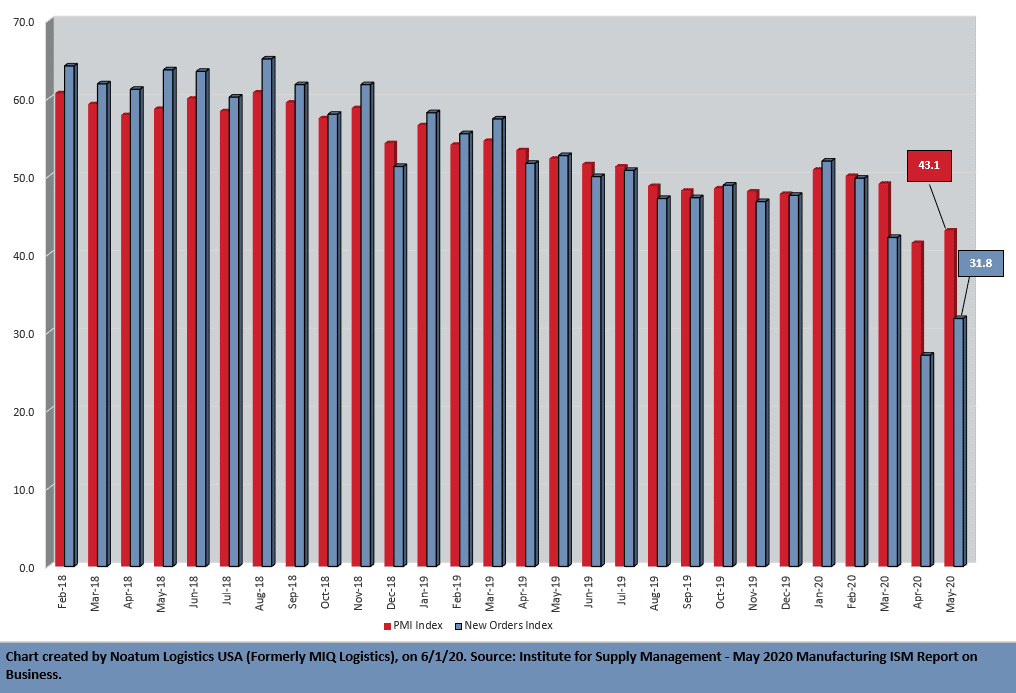Source: Institute for Supply Management – June 1, 2020
Economic activity in the manufacturing sector contracted in May, and the overall economy returned to expansion after one month of contraction, say the nation’s supply executives in the latest Manufacturing ISM® Report On Business®.

The report was issued today by Timothy R. Fiore, CPSM, C.P.M., Chair of the Institute for Supply Management® (ISM®) Manufacturing Business Survey Committee: “The May PMI® registered 43.1 percent, up 1.6 percentage points from the April reading of 41.5 percent. This figure indicates expansion in the overall economy after April’s contraction, which ended a period of 131 consecutive months of growth. The New Orders Index registered 31.8 percent, an increase of 4.7 percentage points from the April reading of 27.1 percent. The Production Index registered 33.2 percent, up 5.7 percentage points compared to the April reading of 27.5 percent. The Backlog of Orders Index registered 38.2 percent, an increase of 0.4 percentage point compared to the April reading of 37.8 percent. The Employment Index registered 32.1 percent, an increase of 4.6 percentage points from the April reading of 27.5 percent. The Supplier Deliveries Index registered 68 percent; though down 8 percentage points from the April figure of 76 percent, this high reading elevated the composite PMI®.
“The Inventories Index registered 50.4 percent, 0.7 percentage point higher than the April reading of 49.7 percent. The Prices Index registered 40.8 percent, up 5.5 percentage points compared to the April reading of 35.3 percent. The New Export Orders Index registered 39.5 percent, an increase of 4.2 percentage points compared to the April reading of 35.3 percent. The Imports Index registered 41.3 percent, a 1.4-percentage point decrease from the April reading of 42.7 percent.
“Three months into the manufacturing disruption caused by the coronavirus (COVID-19) pandemic, comments from the panel were cautious (two cautious comments for every one optimistic comment) regarding the near-term outlook. As was the case in April, the PMI® indicates a level of manufacturing-sector contraction not seen since April 2009; however, the trajectory improved. Demandcontracted heavily again, with the (1) New Orders contracting at a strong level, again pushed by New Export Orders contraction; both indexes contracted at slower rates, (2) Customers’ Inventories Index returning to a level considered a positive for future production, and (3) Backlog of Orders Index remaining in strong contraction territory, in spite of weak production during the period. Consumption(measured by the Production and Employment indexes) contributed positively (a combined 10.3-percentage point increase) to the PMI® calculation, with many panelists classified as non-essential beginning to return to work in late May. Inputs — expressed as supplier deliveries, inventories and imports — strengthened again due to supplier delivery issues that were partially offset by continuing imports sluggishness. The delivery issues were the result of disruptions in domestic and global supply chains, driven primarily by supplier plant shutdowns. Inventory expanded due to issues with throughput and demand weakness. Inputs contributed negatively (a combined 7.3-percentage point decrease) to the PMI® calculation. (The Supplier Deliveries and Inventories indexes directly factor into the PMI®; the Imports Index does not.) Prices continued to contract (but at a slower rate in May), supporting a negative outlook.
“The coronavirus pandemic impacted all manufacturing sectors for the third straight month. May appears to be a transition month, as many panelists and their suppliers returned to work late in the month. However, demand remains uncertain, likely impacting inventories, customer inventories, employment, imports and backlog of orders. Among the six biggest industry sectors, Food, Beverage & Tobacco Products remains the only industry in expansion. Transportation Equipment; Petroleum & Coal Products; and Fabricated Metal Products continue to contract at strong levels,” says Fiore.
Of the 18 manufacturing industries, the six that reported growth in May — in the following order — are: Nonmetallic Mineral Products; Furniture & Related Products; Apparel, Leather & Allied Products; Food, Beverage & Tobacco Products; Paper Products; and Wood Products. The 11 industries reporting contraction in May, in order, are: Printing & Related Support Activities; Primary Metals; Transportation Equipment; Petroleum & Coal Products; Fabricated Metal Products; Machinery; Miscellaneous Manufacturing; Electrical Equipment, Appliances & Components; Chemical Products; Computer & Electronic Products; and Plastics & Rubber Products.
Click here to access the entire release from the Institute for Supply Management website.
